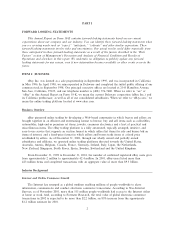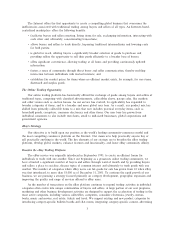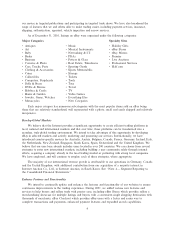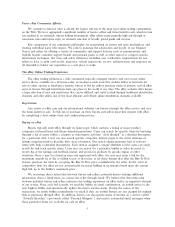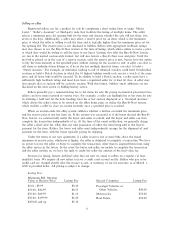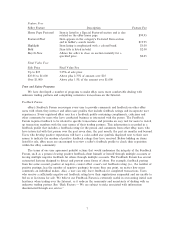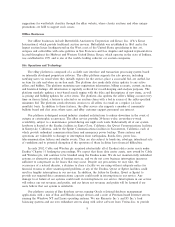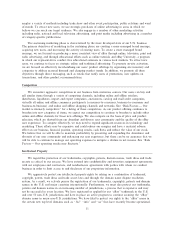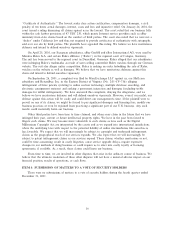eBay 2001 Annual Report Download - page 14
Download and view the complete annual report
Please find page 14 of the 2001 eBay annual report below. You can navigate through the pages in the report by either clicking on the pages listed below, or by using the keyword search tool below to find specific information within the annual report.
for fault tolerance. We have experienced periodic system interruptions, which we believe will continue to
occur from time to time. These outages have stemmed from a variety of causes, including third-party
hardware and software problems, human error and eBay proprietary software issues. The volume of traÇc
on our website and the number of items being listed by users has been increasing continually, requiring us
to expand and upgrade our technology, transaction processing systems and network infrastructure and add
new engineering personnel. The process of upgrading and expansion is part of the regular maintenance and
site revisions. We may be unable to accurately project the rate or timing of increases, if any, in the use of
the eBay service or expand and upgrade our systems and infrastructure to accommodate these increases in
a timely manner. Any failure to expand or upgrade our systems at least as fast as the growth in demand
for capacity could cause the website to become unstable and possibly cease to operate for periods of time.
Unscheduled downtime could harm our business.
We use internally developed systems to operate our service and for transaction processing, including
billing and collections processing. We must continually improve these systems to accommodate the
increasing levels of use of our website. In addition, we may add new features and functionality to our
services that would result in the need to develop or license additional technologies. The cost of our
development eÅorts totaled $24.8 million in the year ended December 31, 1999, $55.9 million in 2000, and
$75.3 million in 2001, and are displayed in our Consolidated Financial Statements under the heading
""Product development.'' Our inability to add additional software and hardware or to upgrade our
technology, transaction processing systems or network infrastructure to accommodate increased traÇc or
transaction volume could have adverse consequences. These consequences include unanticipated system
disruptions, slower response times, degradation in levels of customer support, impaired quality of the users'
experience on our service and delays in reporting accurate Ñnancial information. Our failure to provide new
features or functionality also could result in these consequences. We may be unable to upgrade and expand
our systems in a timely and eÅective manner or to integrate smoothly any newly developed or purchased
technologies with our existing systems. These diÇculties could harm or limit our ability to expand our
business. See ""Risk Factors Ì The inability to expand our systems may limit our growth and Ì System
failures could harm our business.''
Our competitive space is characterized by rapidly changing technology, evolving industry standards,
frequent new service and product announcements, introductions and enhancements and changing customer
demands. Accordingly, our future success will depend on our ability to adapt to rapidly changing
technologies, adapt our services to evolving industry standards and to improve the performance, features
and reliability of our service in response to competitive service and product oÅerings and evolving demands
of the Internet. Our failure to adapt to these changes would harm our business. In addition, the
widespread adoption of new Internet, networking or telecommunications technologies or other technological
changes could require substantial expenditures to modify or adapt our services or infrastructure. See ""Risk
Factors Ì Our failure to manage growth could harm us, Ì We must keep pace with rapid technological
change to remain competitive and Ì We need to develop new services, features and functions in order to
expand.'' To address the need for rapid change as well as stability, we have undertaken a project to
enhance our current architecture. The new architecture is intended to facilitate continued stability,
improved scalability and improved eÇciency. The proposed architecture should also improve search and
listing functionality. This project is ongoing, with phased rollouts through 2003. We plan to time these
rollouts in a way that minimizes the impact to our user community.
Marketing
Our marketing strategy is to promote our brand, attract new buyers and sellers to the eBay service
and increase the activity of existing users. Our marketing eÅorts can be classiÑed into initial and sustaining
phases.
The initial marketing phase is characterized by the earlier stage of website development and growth
exhibited by our international businesses. The primary objectives of marketing in the initial phase are to
build brand awareness and interest and to acquire new users. To build brand awareness and interest, we
10




